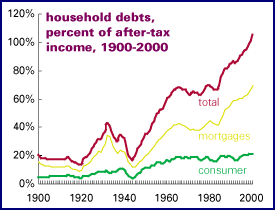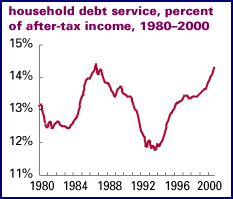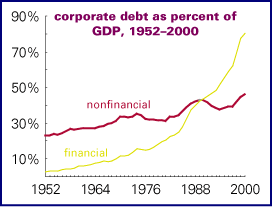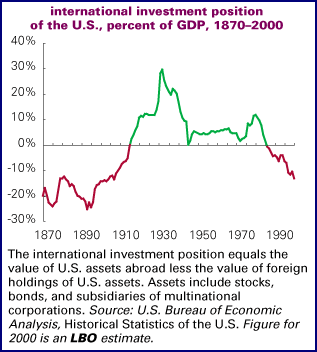Home
Mail Articles
Stats/current
Supplements
Subscriptions
Links
The following article appeared in Left
Business Observer #97, May 2001. It retains its copyright and
may not be reprinted or redistributed in any form - print, electronic,
facsimile, anything - without the permission of LBO.
Debts everywhere
It's been a staple of left writing over the years - a concern shared
by some traditionalists
on the right - that the U.S. economy has a serious debt problem.
To traditionalists, the rampant use of debt is yet another sign
of moral decline. To lefties,  it's
yet another sign of the unsustainability of capitalism. Both share
the sense that there will be some hell to pay. So far, hell hasn't arrived demanding payment, so
the debt numbers keep creeping northward. Either this means that
all the worries, common since the 1970s, are misplaced, or that
the Satanic bill collector's arrival, whenever that happens, will
be more apocalyptic for every delay.
it's
yet another sign of the unsustainability of capitalism. Both share
the sense that there will be some hell to pay. So far, hell hasn't arrived demanding payment, so
the debt numbers keep creeping northward. Either this means that
all the worries, common since the 1970s, are misplaced, or that
the Satanic bill collector's arrival, whenever that happens, will
be more apocalyptic for every delay.
Here's a rehearsal of some of the reasons to be worried. While
the federal government has been busily paying off its debts -
and state and local ones never had much of a debt problem to begin
with -U.S. households and businesses haven't had a date with prudence
in a decade. And the U.S. as a whole has been running up its debts
to foreign creditors at a vigorous pace for almost 20 years.
The charts tell most of the story, but a few words about each
might help. The first shows the ratio of household debts to after-tax
income, the best way to measure the level of debt over time, since
dollar amounts alone would be fairly meaningless, given inflation
and economic growth. There are two major kinds of personal debt
- "consumer, " which means mostly credit cards, and mortgages, which are mostly
on owner-occupied housing. Though credit card debt has been rising
steadily - from a total equal to about 18% of after-tax income
ten years ago to 22% today - that rise is dwarfed by the increase
in mortgage debt, as people take out more aggressive mortgages
(putting down little or no money at the outset) or borrow against
the value of their houses to buy projection TVs or pay orthodontist
bills. Looked at another way, homeowners' equity equaled 83% of
the value of their real estate in 1950 ,
69% in 1980 - and 54% at the end of last year.
,
69% in 1980 - and 54% at the end of last year.
OK, that's the story of debt levels - but how burdensome is
it to service them. The next chart shows the share of after-tax
income devoted to interest and principal payments. At the end
of last year, households devoted over 14% of their after tax income
to servicing debts - one out of every seven dollars, and more
than the average household spends on food. That's a hair below
the record set at the end of 1986, when debt levels were lower,
but interest rates were higher. But in the 1980s, the debt service
burden fell as the decade went on; in the 1990s, it rose. The
previous long rise, in the early 1980s, was during a period of
recession and high interest rates; god only knows what a round
of bad times would do.
The third chart shows what's been happening with corporate
debts, with separate lines showing firms engaged primarily in
financial businesses (who mainly borrow to lend again) and those
in nonfinancial businesses (though a car company like Ford also
runs a finance subsidiary that lends money to people buying cars
and trucks). Note that these lines march generally upwards - though
nonfinancial firms took a breather in the late 1980s and early
1990s, after the mad leveraging of the 1980s - drove some corporations
into the ground, and more to the brink.
And finally, the last chart, the U.S. financial position relative
to the rest of the world. (This measure includes all kinds of
instruments, not just debts - like stockholdings and corporate
subsidiaries - but debt is the major factor.) Throughout the 19th
century, U.S. entities (people and businesses) owed more to foreigners
than foreigners owed to U.S. entities. But in the years before
World War I, this reversed, and the U.S. became a creditor on
the international scene. The political way to read this is that
during the 19th century, the U.S. was a "developing"
country, borrowing from more mature European economies to finance
rapid growth. By the turn of the century, the U.S. was well on
its way to becoming the world's dominant industrial and political
force, and others began borrowing from the U.S. But starting in
the early 1980s, this reversed, as the federal government borrowed
heavily, then private entities joined in. That trend has continued
into the 21st century, as our trade deficit has widened - when
you chronically import more than you export, you have to borrow
the difference abroad, and you build up the debts to show it.
These are the facts; the real question is what they mean. Despite
the sounding of many alarms, the U.S. has not yet hit a really
severe debt crunch. Individual households - roughly a million
a year - file for bankruptcy, and many individual businesses are
crushed by their debts, no economy-wide disaster has yet materialized.
Nor have foreign creditors stopped lending fresh money to Americans
and started calling in their existing loans. Optimists look at
the chart of the U.S. international investment position and say
it's like the 19th century all over again, with a technological
revolution lending the spring of youth to the American economic
step. Pessimists say it's unsustainable - that the U.S. is living
beyond its means, and the tab can't be evaded forever.
 The risk level, however, is
very high. Any protracted economic weakness could turn a heavy
debt burden into a killing one - which is no doubt one reason
why the Fed has eased so aggressively at the relatively minor
signs of weakness that have emerged in recent months. But another
question is this: how would the U.S. economy look if it weren't
for all this vigorous borrowing? Would we have had the long boom
of the 1990s if households and businesses had been prudent, and
if we hadn't run up large debts abroad? Probably not.
The risk level, however, is
very high. Any protracted economic weakness could turn a heavy
debt burden into a killing one - which is no doubt one reason
why the Fed has eased so aggressively at the relatively minor
signs of weakness that have emerged in recent months. But another
question is this: how would the U.S. economy look if it weren't
for all this vigorous borrowing? Would we have had the long boom
of the 1990s if households and businesses had been prudent, and
if we hadn't run up large debts abroad? Probably not.
The first Bush regime was essentially a long recovery from
the hangover after the 1980s debt binge. The economy barely grew
for three or four years - a time of rising unemployment, the Angry
Voter, and the growth of militias. What will higher debt levels
and a dumber Bush bring?
Home Mail
Articles
Stats/current
Supplements
Subscriptions
Links
 it's
yet another sign of the unsustainability of capitalism. Both share
the sense that there will be some hell to pay. So far, hell hasn't arrived demanding payment, so
the debt numbers keep creeping northward. Either this means that
all the worries, common since the 1970s, are misplaced, or that
the Satanic bill collector's arrival, whenever that happens, will
be more apocalyptic for every delay.
it's
yet another sign of the unsustainability of capitalism. Both share
the sense that there will be some hell to pay. So far, hell hasn't arrived demanding payment, so
the debt numbers keep creeping northward. Either this means that
all the worries, common since the 1970s, are misplaced, or that
the Satanic bill collector's arrival, whenever that happens, will
be more apocalyptic for every delay. ,
69% in 1980 - and 54% at the end of last year.
,
69% in 1980 - and 54% at the end of last year.
 The risk level, however, is
very high. Any protracted economic weakness could turn a heavy
debt burden into a killing one - which is no doubt one reason
why the Fed has eased so aggressively at the relatively minor
signs of weakness that have emerged in recent months. But another
question is this: how would the U.S. economy look if it weren't
for all this vigorous borrowing? Would we have had the long boom
of the 1990s if households and businesses had been prudent, and
if we hadn't run up large debts abroad? Probably not.
The risk level, however, is
very high. Any protracted economic weakness could turn a heavy
debt burden into a killing one - which is no doubt one reason
why the Fed has eased so aggressively at the relatively minor
signs of weakness that have emerged in recent months. But another
question is this: how would the U.S. economy look if it weren't
for all this vigorous borrowing? Would we have had the long boom
of the 1990s if households and businesses had been prudent, and
if we hadn't run up large debts abroad? Probably not.